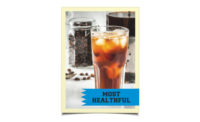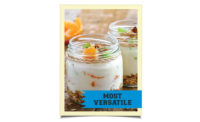As consumers continue to seek out food with clean ingredients, protein on the go, freshness and convenience, cheese is the answer to many of those needs. Over the last year, cheese processors have doubled down on portable snack offerings, from cheese bites to snack packs. Hybrid options (think cheese paired with lunch meats, nuts, fruit and pretzels) are popping up everywhere. Portion control and portability are the keys.
Milk | Cheese | Cultured | Ice Cream | Butter | Non-dairy Beverages | Ingredients | Exports
“Consumers are undeniably demanding healthful, simple ingredients, freshness, nutritional information, consistent quality and portability at an affordable price point. [They’re] looking for products that deliver nutritional value in a versatile way,” said Lori Church, director of sales and marketing, Lioni Latticini Inc., Union, N.J.
On the specialty side, flavor innovation and “artisan” and “handcrafted” cheeses are driving sales, according to several cheesemakers we spoke with.
The “craft movement” is slowly emerging in cheese, according to “Cheese Global Annual Review 2017,” a publication from global market research firm Mintel. As noted in Mintel’s report, “cheeses positioned as (hand) crafted meet consumers’ appetite to know more about products, their makers and the inspiration behind brands. Craft brands of food and drink are associated with high-quality ingredients, small-scale production, and time and care taken in production.”
The story is in the numbers
Cheese production increased to over 12.1 billion pounds in 2016 from 10.8 billion pounds in 2012, according to the USDA’s National Agricultural Statistics Service.
Rachel Kerr, director of PR and events, Wisconsin Milk Marketing Board, Madison, Wis., noted that “growth specifically in specialty cheese, whole-fat cheese, shreds and spreads, organics and natural cheese [is] driving sales in the cheese category.
“The rise in the sale of premium and specialty products is especially true when it comes to cheese. Over the past year (latest 52 weeks), volume sales of specialty cheese have increased by five times as fast as the category as a whole,” Kerr continued, citing data from Chicago-based Information Resources Inc. (IRI), 2015-2016.
Some of the trends helping to fuel this growth are collaboration between cheesemakers, flavor and packaging innovation, and more interest in organic cheese, noted Kerr.
“Organic cheese accounts for less than 1% of volume sales in the total cheese category, but ... it is achieving strong volume growth of 35%,” she added.
As whole-milk options continue to gain popularity across dairy categories, it’s no different with cheese.
“Regular or whole-fat cheese accounts for the lion’s share of volume (92%) of the total cheese category, and is the only segment growing when you break down the total cheese category’s volume sales by fat content,” Kerr said.
And consumers still prefer natural over processed cheese by a landslide.
“Natural cheese accounts for about 82% of the total cheese category’s volume sales and is driving category growth,” Kerr said. “Processed cheese, which accounts for 16% of the total cheese category’s volume sales, has actually posted a decline in sales, as have imitation.”
The natural cheese category’s dollar sales decreased 0.1% to $12.9 billion, and unit sales rose 1.2% to 3.9 billion, for the 52 weeks ended Aug. 6, 2017, according to IRI. For the processed cheese category, dollar sales dropped 1.8% to $2.9 billion, and unit sales decreased 3.4% to 761.3 million.
Cheese is making its mark on restaurant menus as well.
In the last five years, cheese has grown 3.7% on menus, according to MenuMonitor from Chicago-based Technomic. The top three cheeses you are likely to find at your local restaurant are cheddar, mozzarella and Parmesan. Meanwhile, the fastest growing cheeses in U.S. foodservice in the last year were Danish blue cheese, Grana Padano (a hard Italian cheese, similar to Parmesan) and Asadero (a Mexican-style melting cheese), according to Technomic.
Convenience dominates
The snacking movement taking over the food industry has had a big impact on cheese. Walk through the cheese and lunch meat aisles in the grocery store and you’ll find several options for cheese snack packs and other on-the-go cheese options.
“Moving way beyond the string cheese sticks of the past, the industry has responded with diverse product offerings, including convenient ready-to-eat formats such as cubes, as well as snack packs that include cheese, nuts, meat and fruit,” noted Kareen Stephens, brand manager, Schuman Cheese, Fairfield, N.J.
Schuman makes single-serve portion packs of cheese under its Cello brand that are conveniently packaged in 0.75-ounce and 1-ounce cups, sold in a four-pack. The grab-and-go varieties include aged Parmesan shaves, Dutch Gouda slices and sharp cheddar cubes and slices. The company also added an Asiago and Pepper Jack flavor to its popular Cello Whisps line. The Whisps are made with just one ingredient — cheese — and are baked to a crispy snack. They’re sold in shelf-stable resealable stand-up pouches. A serving of 23 Whisps contains 10 to 13 grams of protein.
“Flexible stand-up pouches containing ready-to-eat on-the-go dairy products are trending,” said Lioni’s Church. “Innovative packaging options are very popular and necessary today to address retail shelf space and customer brand recognition.”
Lioni introduced an on-the-go package of what it calls “artisan” fresh mozzarella. The snack bites are available in resealable stand-up pouches that contain six individual vacuum-sealed four-packs.
“Today’s lifestyle calls for eating throughout the day, and consumers are no longer sitting down for their ‘three meals a day’ as they did in years past. Instead, we are a substantial snacking and grazing nation,” said Valerie Liu, marketing manager, Norseland Cheese, Darien, Conn.
Heather Engwall, director of marketing for Emmi Roth, Monroe, Wis., said that “another big trend is the blending of e-commerce and brick and mortar as more retailers focus on ordering online and convenience for their shoppers. We’ve seen great examples of this as Amazon buys Whole Foods and Walmart and Google partner, as we’re sure to see more on the horizon.
“As a whole, the food industry is beginning to focus less on their products and more on how to make people’s lives easier. Grocery stores are building up their prepared food areas; meal kits are popping up everywhere; and dairy companies are focusing how people eat dairy, not just what they eat,” Engwall added.
Snack attack
There have been a slew of innovative new snack and convenience cheese products to hit stores over the past year.
Finlandia Cheese, Parsippany, N.J., introduced SnackTime, a premium aged and imported cheese stick line. The non-GMO cheese sticks are available in three flavors: Gouda, cheddar & Gruyere, and Gouda & sharp Parmesan. Meanwhile, BelGioioso Cheese, Green Bay, Wis., added Parmesan cheese to its snacking cheese line. Eight individually wrapped pieces are packaged in a bag for portion control. The cheese contains 80 calories and 7 grams of protein per 0.75-ounce serving.
Last year, Jarlsberg, a brand of Norseland Cheese, launched two products that fall into the convenient category — cheese Folios, lightly baked sheets of cheese that can be made into a gluten-free wrap, and Cheese Snacks. Cheese Folios can be used for roll-ups or sandwich wraps, or baked to create a shell for salad; Cheese Snacks are semi-soft cheese sticks.
And Waitsfield, Vt.-based Cabot Creamery introduced Cracker Cuts, a line of naturally aged cheese that comes in pre-cut cracker-size portions. The package has a resealable lid to keep the cheese fresh over multiple snacking sessions. They come in six varieties, such as seriously sharp white cheddar, seriously sharp yellow cheddar and Pepper Jack. The yellow cheddar contains 8 grams of protein per four slices.
Offering up more diversity in cheese stick varieties, Basking Ridge, N.J.-based Arla Foods introduced snack cheeses available in three varieties: Gouda, Havarti and medium cheddar. The cheese is sold in packages containing eight individually wrapped 0.75-ounce portions. And Saputo Cheese USA Inc., Lincolnshire, Ill., introduced portable snacking cheese under its Great Midwest brand. Options include 12-ounce bags of cheese cubes (available in mild cheddar and pepper Jack) and “Snackin’ Cheese,” a mixture of snack-sized string cheese and cheddar cheese bites, sold in a 6-ounce bag.
In snack pack news, Horizon Organic, a brand of DanoneWave, Broomfield, Colo., launched Good & Go packs that feature cheese paired with nuts, dried fruit or pretzels. They’re sold in 1.26-ounce packages. The cheddar and pretzels variety contains 6 grams of protein per pack. Meanwhile, Chicago-based Kraft Heinz launched Snack Trios, which feature cheese, dark chocolate and sweet fruit. A 1.5-ounce pack contains 4 grams of protein.
And Sargento Foods, Plymouth, Wis., expanded its Balanced Breaks brand (its 1.5-ounce snack packs) with the release of a sweet line. The snack combines natural cheese with sweet ingredients such as dried fruits and dark chocolate. It comes in four varieties, including Monterey Jack cheese, dried cranberries and dark chocolate-coated peanuts.
Thinking along the mini-meal idea, Minnetonka, Minn.-based Michael Foods, parent company of Crystal Farms, launched Ready, Egg, go!, a fresh protein pack that contains a hard-boiled egg, nuts and cheese. It’s available in four varieties, including pistachios and cheddar, which contains 16 grams of protein per 3.75-ounce container.
Spicing up specialty cheeses
As we noted earlier, flavor innovation is a driving force in the specialty cheese category. At last summer’s Fancy Food Show in New York, we saw cheese manufacturers pushing the envelope with new culinary-inspired flavors, sweet (e.g., chocolate) flavors, spicy varieties and fruit-infused flavors (such as coconut and blueberry).
“Trendy flavors [such as] habenero mango are popular in the cheese category,” noted TW Bacon, director of retail at Sartori Cheese, Plymouth, Wis.
Capturing both convenience and bold flavors, Cheese Fusions, another Norseland Cheese brand, is a flavored cheese snack sold in individual pouches. The cheese comes in four flavor varieties, including sour cream and onion Monterey Jack; buffalo Monterey Jack and smoked chipotle cheddar. Emmi Roth added a new flavor in its Roth line of cheeses from Wisconsin — Sriracha Gouda. The company said the cheese merges the mild flavor of Roth’s Dutch-style Gouda with spicy, tangy-sweet and savory Sriracha spices.
Sincerely, Brigitte, a brand of Anderson International Foods Inc., Jersey City, N.J., created a diced cheese product for salads and/or snacking that includes some unique flavors — such as chipotle cheddar and garlic basil Monterey Jack. The cheese is sold in four-packs of 1-ounce single on-the-go cups and 3-ounce cups. Finlandia also added two flavors (zesty pepper and smooth horseradish) to its creamy gourmet cheese line, a product used for spreading, dipping, baking and cooking. The new flavors join other sweet and savory options such as black garlic, garden dill and vanilla bean.
Saputo also launched some unique flavors under its Great Midwest brand — Pesto Jack (Monterey Jack with garlic and basil pesto) in 8-ounce rounds; and Mediterranean cheddar (a blend of sun dried tomatoes, Kalamata olives and spices) in 7-ounce bars. Old Croc, maker of grass-fed Australian cheeses, distributed by Trugman-Nash LLC, Millburn, N.J., added several flavored cheddars in 6-ounce sizes — horseradish, bacon & jalapeno, roasted garlic & herb and chipotle & onion.
Other cheese brands appealed to consumers’ desire for more premium and organic options.
Tillamook County Creamery Association, Tillamook, Ore., introduced a complete reformulation of its shredded cheese products with its new Farmstyle Cut line. The company also added a new Sharp White shredded cheese flavor, joining the other 10 varieties, including cheddar Jack, Mexican four-cheese and Italian blend. The cheeses offer a unique, hand-grated texture that have an ideal melt, stretch, texture and flavor for specific culinary purposes, according to the company.
Under its Stella brand, Saputo created Cheese Pillow Bags (shredded Parmesan, shaved Parmesan and a three-cheese blend of shredded Asiago, Parmesan and Romano cheeses), available in 8-ounce bags.
Emmi Roth also introduced Roth Organics, a new collection of four cheeses made with organic milk. The line features its Grand Cru Original, Van Gogh Gouda, Havarti and sharp cheddar. The Grand Cru is an Alpine-style cheese. The cheeses are sold in wheels, loaves, blocks and retail cuts.
New challenges bring opportunities
“While per-capita consumption of cheese continues to grow in the United States, our consumption still trails rates in many other countries,” said Terry Brockman, president and COO, Saputo. “Continuing to grow per-capita consumption and household penetration by expanding consumers’ cheese palates into additional varieties and flavors — cheeses like blue, feta, goat and Italian cheeses, beyond mozzarella and Parmesan — could drive category growth for the years to come.”
Future growth is also impacted by how consumers shop, not only what they are shopping for.
“The way consumers are shopping has had a big impact on the cheese category. With online shopping at a boom, and more consumers using online grocery options, we have to continuously find ways to be relevant online — and for a specialty cheese company whose products are in the deli, and often cut and wrap, that is a challenge,” said Emmi Roth’s Engwall. “Our marketing team has shifted significantly over the past year to focus on online retailers, e-commerce, social/digital advertising and staying relevant in today’s digital marketplace.”
But as Engwall puts it, the industry’s challenges bring great opportunities.
“As consumers flock to social media and online reviews to determine their purchases, we have an opportunity to be in those spaces and impact purchase decisions before they walk into the store or type a cheese name into the search bar in their online shopping portal,” she said.
Milk | Cheese | Cultured | Ice Cream | Butter | Non-dairy Beverages | Ingredients | Exports








